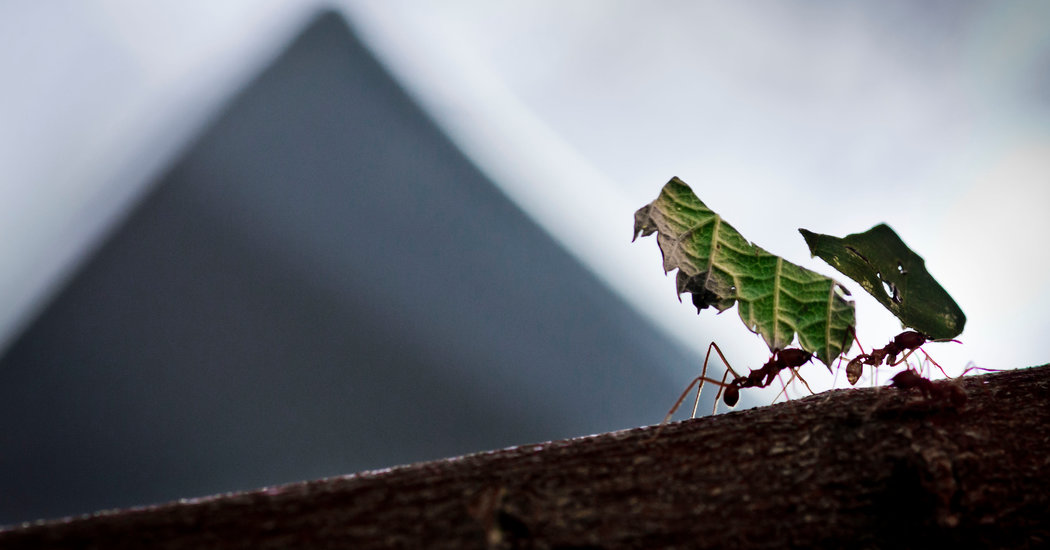
As a microbiologist, Massimiliano Marvasi has spent years studying how microbes have defeated us. Many pathogens have evolved resistance to penicillin and other antimicrobial drugs, and now public health experts are warning of a global crisis in treating infectious diseases.
These days, Dr. Marvasi, a senior researcher at the University of Florence in Italy, finds solace in studying ants.
About 240 species of ants grow underground gardens of fungi. They protect their farms against pathogens using powerful chemicals secreted by bacteria on their bodies. Unlike humans, ants are not facing a crisis of antimicrobial resistance.
Writing in the journal Trends in Ecology and Evolution, Dr. Marvasi and his colleagues argue that fungus-farming ants could serve as a model for drug development. It’s not just that they have antimicrobials — it’s how they use their drugs.
Fungus-farming ants bring leaves or other debris to gardens in their nests, where certain kinds of fungi thrive. The fungi — which can flourish nowhere else — grow into dense webs that the ants feed to their larvae.
But the crops are also attractive to a parasitic fungus called Escovopsis. It attacks the gardens and starves the ants.
“It’s a war between the ants and the pathogens for the same food,” Dr. Marvasi said.
The ants have powerful allies in this war: bacteria that live on their thoraxes. Worker ants coat eggs with certain strains of these bacteria. As an ant matures, it feeds its personal supply of bacteria with secretions from glands on its thorax.
The bacteria pay the ants back for this special care by making powerful antimicrobials that kill Escovopsis, protecting the gardens from destruction.
The fact that bacteria make antimicrobials is hardly surprising. The ones that doctors prescribe today were mostly discovered in the soil, made by microbes. What is surprising is that the chemicals used by the ants work so well.
Escovopsis has evolved defenses against the bacteria, producing compounds that inhibit their growth. And yet the ants still manage to keep these pathogens in check.
Dr. Marvasi and his co-authors — Ayush Pathak of Imperial College London and Steve Kett of Middlesex University London — argue that we would do well to look more closely at the ants to figure out the secrets to their success.
One important advantage is that the bacteria on ants make several antimicrobials at once. “It’s an impressive chemical factory,” said Dr. Marvasi.
Powerful evolutionary forces create this variety, said Sarah Worsley, a senior research associate at the University of East Anglia in England, who was not involved in the new study.
When the ants forage for garden fertilizer, they pick up random bacteria from the ground. These compete fiercely with the resident microbes for the nutrients provided by the ant glands. Natural selection favors the residents that make powerful antimicrobials that ward off the newcomers.
“These antimicrobials are being produced as a result of this warfare on the ant’s surface,” said Dr. Worsley. “The ants get in on the competition and use those antimicrobials to look after their fungus gardens.”
Researchers are also learning how new antimicrobials evolve. “We’re accumulating so much new information on the molecular level now,” said Katrin Kellner, a molecular ecologist at the University of Texas at Tyler.
Sometimes resident bacteria on ants take up a gene from competitors. The protein made by the new gene may then alter the shape of an existing antimicrobial.
Other mutations may shuffle genetic switches in the bacteria’s DNA. As a result, it may produce new antimicrobial compounds.
But Ulrich Mueller, an evolutionary biologist at the University of Texas at Austin, warned that scientists may not yet understand the ants well enough to learn from their success.
Some antimicrobials that kill Escovopsis, for example, also seem to defend the ants from their own infections. It’s possible that their evolution has little to do with protecting fungal gardens.
“That dimension has been completely ignored,” Dr. Mueller said.
Dr. Marvasi and his colleagues are investigating the evolutionary competition between the bacteria on ants and Escovopsis, pitting the organisms against one another in Petri dishes.
They want to see if the combination of related antimicrobials is the secret to the ants’ success. Mimicking that strategy might help keep our own antimicrobial drugs potent.
“The idea is maybe to have one main antibiotic, but in a mixture of similar antibiotics,” Dr. Marvasi said.
Dr. Worsley and her colleagues are reproducing the evolution of the bacteria living on the ants. The scientists are tweaking the bacterial genes that produce antimicrobials, hoping to discover new compounds that might work on human diseases, rather than garden parasites.
“We’re shortcutting evolution by taking inspiration from these arms races in the past,” she said.

